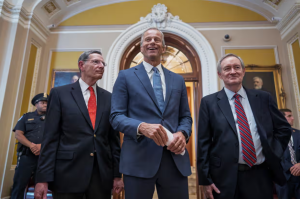President Donald Trump’s tax-cut and spending bill, which passed Congress on Thursday, averts the near-term prospect of a U.S. government default but makes America’s long-term debt problems even worse.
Republican lawmakers in the House of Representatives approved the bill that will extend Trump’s 2017 tax cuts, authorize more spending on border security and the military, make steep cuts in Medicare and Medicaid – and add trillions to the government’s debt. Trump is expected to sign the bill into law.

As part of the tax package, lawmakers raised the U.S. government’s $36.1 trillion borrowing limit that it was projected to hit later this summer by $5 trillion – a move that will assuage concerns over a possible default on U.S. debt.
Analysts had estimated the so-called X-date, when the Treasury would no longer be able to pay all of its obligations without an increase or suspension of the debt limit, could have occurred at the end of August or in early September.
Longer term, however, the bill has largely been seen as bad news for the U.S. bond market and the nation’s fiscal health. It will add $3.4 trillion to the nation’s debt over the next decade, nonpartisan analysts have estimated.
That would exacerbate concerns over additional bond supply and dwindling demand for U.S. Treasuries that have been a key driver of financial markets in recent months.
“The bill contributes to some of the structural concerns around Treasuries, with respect to No. 1, ongoing fiscal deficit and elevated debt levels, and No. 2, inflation,” said Mike Medeiros, macro strategist at Wellington Management.
BlackRock warned on Monday that foreign buyers were already souring on American debt. There was a real risk that demand for the $500 billion in debt the U.S. issues every week will fall even more and push borrowing costs higher.
“We’ve been highlighting the precarious position of the U.S. government’s indebtedness for some time now, and, if left unchecked, we view debt as the single greatest risk to the ‘special status’ of the U.S. in financial markets,” BlackRock’s investment managers said in a note.
The bill is projected to reduce tax revenues by $4.5 trillion, reduce spending by $1.2 trillion and cost 10.9 million people their federal health insurance over the next decade, according to estimates from the Congressional Budget Office.
The legislation also stokes economic growth by allowing businesses to fully expense equipment purchases as well as research and development costs, and provides other tax breaks.
Some investors, however, worry the debt overhang could curtail the economic stimulus in the bill, which Trump refers to as the “One Big Beautiful Bill”.
Campe Goodman, fixed-income portfolio manager at Wellington Management Company, said he expected the bill to add as much as 0.5% to economic growth next year, but that the market was too complacent about the long-term risk of higher borrowing costs.
“We believe the One Big Beautiful Bill will accelerate corporate earnings growth, which ultimately will drive equity values,” said Ellen Hazen, chief market strategist at F.L. Putnam Investment Management. “But this could lead to higher-for-longer Treasury rates, making many fixed-income investments somewhat less attractive over the longer term,” she said.
Benchmark 10-year Treasury yields were higher on Wednesday after days of decline, with the increase partly attributed to fiscal concerns agitating investors. Yields rise when bond prices drop.
Andrew Brenner, head of international fixed income at National Alliance Capital Markets, said Wednesday’s selloff was a sign that so-called bond vigilantes – investors who punish bad policy by making it prohibitively expensive for governments to borrow – were circling the market.
“The Vigilantes want to see more deficit cutting… Their view is Trump and Congress have not done enough,” he wrote in a note to clients on Wednesday.
DEBT LIMIT RELIEF
By raising the U.S. federal borrowing limits, the bill removes the low-probability but high-impact risk of a U.S. debt default, which could have catastrophic consequences for global markets.
In recent weeks, the interest rate on some Treasury debt due in August had risen more than yields of short-term Treasury bills coming due around the same time, a sign investors were getting nervous about the approaching X-date.
“I think (the passage of the bill) takes some of the debt ceiling risks away so yields on bills maturing in August might come down a little bit,” said Vinny Bleau, director of fixed-income capital markets at Raymond James in Memphis.
Overall, the reaction of the bond market to the bill approval has been relatively muted. An expansion in deficits had already been priced in with Trump’s return to the White House in January, and investor focus has shifted in recent weeks to economic growth concerns.
To be sure, many market participants said the passage of the bill was secondary to other key market drivers. The benchmark S&P 500 Index (.SPX), opens new tab closed at a record high on Wednesday, lifted by gains in tech stocks and progress on U.S. trade agreements.
A slowdown in economic data in recent weeks has also bolstered expectations for interest rate cuts by the Federal Reserve this year, contributing to optimism in stocks and bonds, although a blowout jobs report on Thursday dampened hopes for any immediate easing in monetary policy.
“It’s not going to be the overall driving factor (for the market),” said Robert Pavlik, senior portfolio manager at Dakota Wealth in Fairfield, Connecticut.
“It’s earnings first and then the Federal Reserve,” he said.
Reprinted from Reuters

